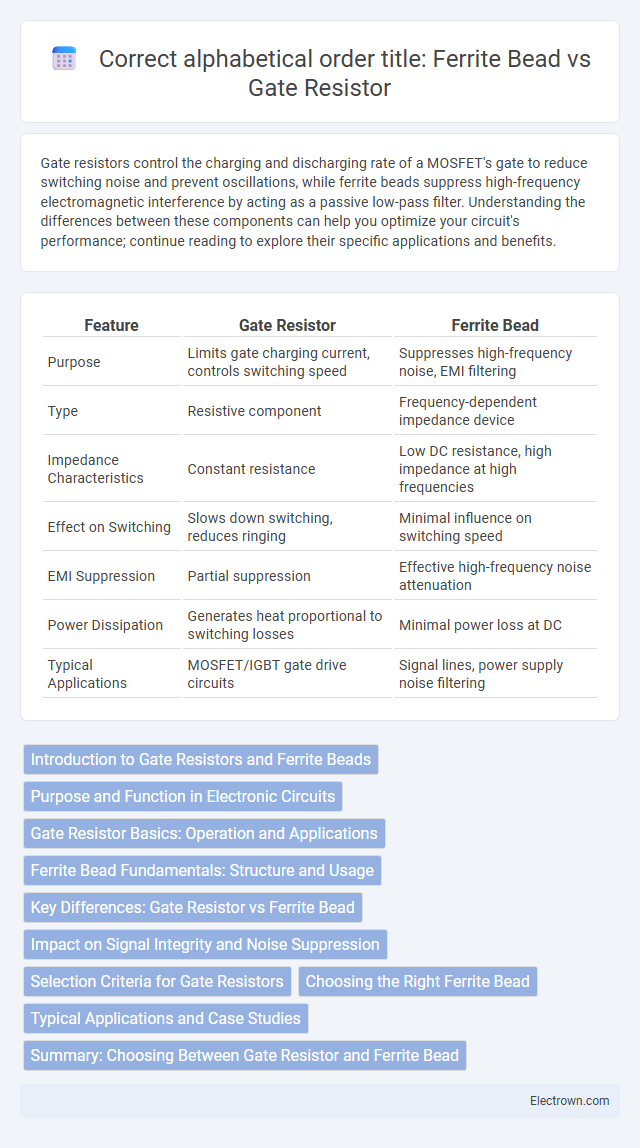Gate resistors control the charging and discharging rate of a MOSFET's gate to reduce switching noise and prevent oscillations, while ferrite beads suppress high-frequency electromagnetic interference by acting as a passive low-pass filter. Understanding the differences between these components can help you optimize your circuit's performance; continue reading to explore their specific applications and benefits.
Table of Comparison
| Feature | Gate Resistor | Ferrite Bead |
|---|---|---|
| Purpose | Limits gate charging current, controls switching speed | Suppresses high-frequency noise, EMI filtering |
| Type | Resistive component | Frequency-dependent impedance device |
| Impedance Characteristics | Constant resistance | Low DC resistance, high impedance at high frequencies |
| Effect on Switching | Slows down switching, reduces ringing | Minimal influence on switching speed |
| EMI Suppression | Partial suppression | Effective high-frequency noise attenuation |
| Power Dissipation | Generates heat proportional to switching losses | Minimal power loss at DC |
| Typical Applications | MOSFET/IGBT gate drive circuits | Signal lines, power supply noise filtering |
Introduction to Gate Resistors and Ferrite Beads
Gate resistors control the switching speed in power devices by limiting the inrush current to the gate, thus reducing electromagnetic interference (EMI) and ringings. Ferrite beads act as high-frequency noise suppressors, providing impedance to high-frequency signals and attenuating electromagnetic noise on power lines or signal traces. Both components are essential in managing signal integrity and minimizing EMI in electronic circuits.
Purpose and Function in Electronic Circuits
Gate resistors primarily limit the inrush current and control the switching speed of MOSFETs, reducing electromagnetic interference (EMI) and preventing voltage overshoot in power electronic circuits. Ferrite beads act as high-frequency noise filters by dissipating high-frequency signals as heat, effectively suppressing EMI and signal ringing on power lines and signal traces. Both components improve circuit stability and signal integrity but serve distinct functions: gate resistors shape transistor switching behavior, while ferrite beads filter high-frequency noise.
Gate Resistor Basics: Operation and Applications
Gate resistors limit the inrush current to a MOSFET gate, controlling switching speed and reducing voltage spikes caused by parasitic inductance. They are essential in power electronics to stabilize gate drive signals and prevent oscillations during transistor switching. Your choice of gate resistor value directly influences device reliability and electromagnetic interference (EMI) performance.
Ferrite Bead Fundamentals: Structure and Usage
Ferrite beads are passive electronic components composed of a magnetic core made from ferrite material that acts as a high-frequency noise filter by dissipating electromagnetic interference (EMI) as heat. Unlike gate resistors, which primarily control switching speed and reduce voltage spikes in MOSFETs by adding resistance in series with the gate, ferrite beads are used to suppress high-frequency noise across a wide frequency spectrum in power lines and signal paths. Their unique structure enables them to provide effective EMI attenuation while maintaining low resistance at DC, making them essential in maintaining signal integrity and reducing radiated emissions in electronic circuits.
Key Differences: Gate Resistor vs Ferrite Bead
Gate resistors primarily limit inrush current and dampen voltage spikes in transistor gates, enhancing switching performance and reducing electromagnetic interference (EMI). Ferrite beads act as high-frequency noise filters by suppressing EMI and radio frequency interference (RFI) across a broad frequency spectrum without significantly affecting DC signals. The key difference lies in their primary function: gate resistors control transient current and switching behavior, while ferrite beads focus on attenuating high-frequency noise in electronic circuits.
Impact on Signal Integrity and Noise Suppression
Gate resistors primarily improve signal integrity by controlling the gate drive current, reducing voltage overshoot and ringing in switching transistors, which minimizes electromagnetic interference (EMI). Ferrite beads serve as high-frequency noise suppressors by attenuating high-frequency noise and preventing it from propagating through the gate drive line, thus enhancing overall noise suppression. Combining gate resistors with ferrite beads is a common practice in power electronics to optimize both switching performance and electromagnetic compatibility (EMC).
Selection Criteria for Gate Resistors
When selecting gate resistors, consider factors such as switching speed control, power dissipation, and EMI reduction, ensuring compatibility with the gate charge of the MOSFET or IGBT. Gate resistors are chosen to optimize the turn-on and turn-off times, prevent voltage overshoot, and control ringing, which directly affects your circuit's reliability and efficiency. While ferrite beads primarily serve as high-frequency noise suppressors, gate resistors must be chosen based on specific electrical characteristics and transient response requirements.
Choosing the Right Ferrite Bead
Choosing the right ferrite bead involves evaluating frequency range, impedance characteristics, and current rating to effectively suppress high-frequency noise in sensitive circuits. Unlike gate resistors that primarily control switching speed and voltage spikes in MOSFETs, ferrite beads provide targeted electromagnetic interference (EMI) attenuation without impacting signal integrity. Selecting a ferrite bead with an impedance peak matching the noise frequency ensures optimal filtering performance in power supply lines and signal paths.
Typical Applications and Case Studies
Gate resistors are commonly used in power electronics to control the switching speed of transistors, reducing electromagnetic interference (EMI) and ringing in high-frequency circuits. Ferrite beads serve as high-frequency noise suppressors in signal lines and power rails, effectively attenuating unwanted radio frequency interference (RFI) in sensitive electronics, such as communication devices and precision measurement equipment. Your choice between a gate resistor and a ferrite bead depends on whether the application focuses on managing transistor switching behaviors or filtering high-frequency noise in signal or power lines.
Summary: Choosing Between Gate Resistor and Ferrite Bead
Gate resistors control switching speed and reduce voltage overshoot in MOSFETs, improving circuit stability and minimizing electromagnetic interference (EMI). Ferrite beads suppress high-frequency noise by providing high impedance at specific frequencies, effectively filtering EMI in power lines and signal paths. Your choice depends on whether the primary goal is controlling transistor switching behavior or attenuating high-frequency noise in the circuit.
Gate resistor vs Ferrite bead Infographic

 electrown.com
electrown.com